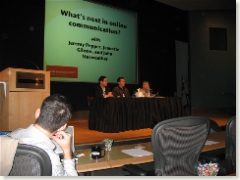 Jeremy Pepper, Jeanette Gibson from Cisco and John Starweather from Microsoft kicked off the conference with a session titled What’s Next in Online Communications?
Jeremy Pepper, Jeanette Gibson from Cisco and John Starweather from Microsoft kicked off the conference with a session titled What’s Next in Online Communications?
John Starweather led off by talking about Microsoft as a place to blog and a place to innovate. John is involved in the Mobius project which is developing new applications and platforms for mobile technologies. He believes that we will soon see even more useful applications for mobile devices.
Jeanette talked about Cisco’s efforts to use the new social media to develop feedback and communication with customers and users.
One of the audience members asked the panelists about their efforts to educate employees about the potential for engagement and how these tools can be used internally. John responded that he believes that most marketers have not yet grasped the full potential of social media and the changed relationships with consumers. As he talks to people internally, people are demanding data. And this is an area that must be focused upon. Good data to show what is really happening.
Jeanette says that Cisco’s CEO communicates with employees using Vlogs. They have an IPtv network internally. They’ve also developed an internal Wiki to share information.
A couple members of the audience raised questions about Second Life. One questioner asked Jeremy about his views on crayon’s Second Life presence. Jeremy suggested that Second Life provides the crayon partners with a presence in a single “place.” This overcomes the fact that they are geographically dispersed in four cities thousands of miles across. As such, it’s a clever move.
John suggested that the future will see mobile devices becoming as ubiquitous and non-intrusive as watches have become. Developers should watch this closely and be sure to design for the small screens of these devices.
How can social media be proved and sold internally? Jeanette suggested that she and her colleagues are spending a great deal of time trying to find indicators of effectiveness. For their web newsroom, they attempt to identify the social media opinion leaders and to demonstrate that these people will generate content that will lead mainstream media coverage.
There were no great new insights at this session. But is was a nice warm-up for the audience. And the best indicator for this was the buzz that began in the auditorium immediately after the session as members of the audience turned to one another and kept the conversation going.
